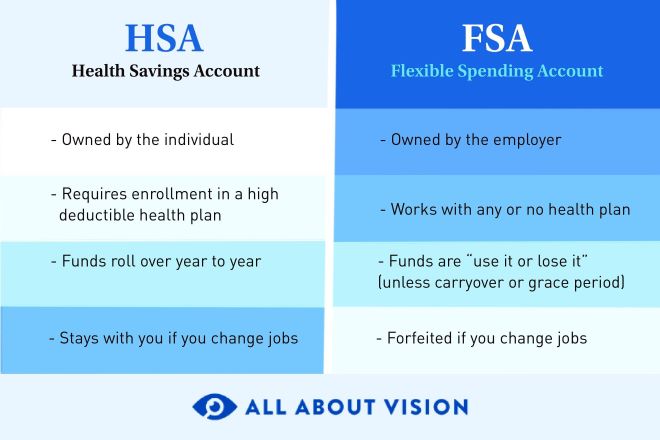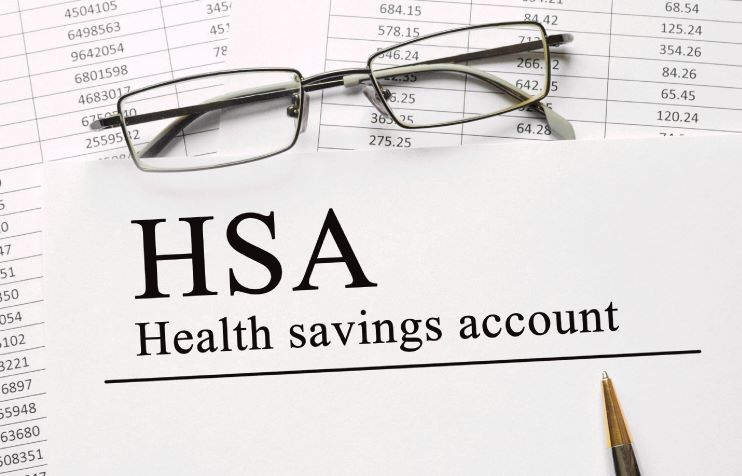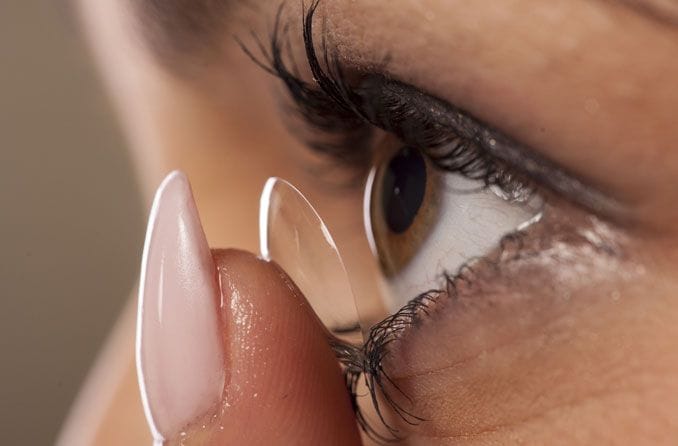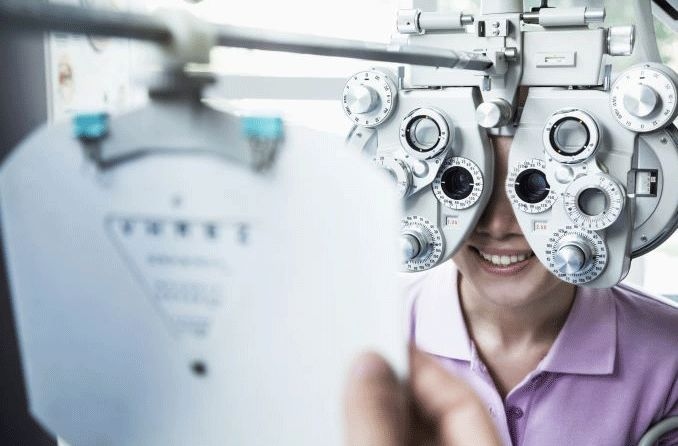What are HSAs and FSAs?
Health savings accounts (HSAs) and flexible spending accounts (FSAs) are tax-advantaged accounts that enable individuals to use pre-tax dollars to cover eligible medical expenses. This can help save money on out-of-pocket health care costs, including glasses and other types of eyewear.
FSA Features
FSAs are set up by an employer and typically funded through pre-tax payroll deductions. Health insurance coverage is not required to be eligible for this type of account — FSAs work alongside any health plan or none at all. Funds are available at the start of the year but must be used within the plan year. Because FSAs usually follow a “use-it-or-lose-it” rule, any unused money is forfeited at the end of the year.
LEARN MORE: What can I spend FSA dollars on?
HSA Features
HSAs may be set up by an employer or opened by an individual, and can be funded through pre-tax payroll deductions or direct contributions that are tax-deductible. These plans must be paired with a qualified high-deductible health plan (HDHP). Funds stay in the account, roll over each year and can be used for eligible health care costs at any time, even years later. If employment ends, the entire balance remains with the individual, regardless of who contributed the money.
Vision care expenses not covered by health or vision insurance may be eligible for payment through an FSA or HSA plan. The Internal Revenue Service (IRS) determines which items qualify for HSA and FSA use. Plan rules may also vary, so it’s important to check with your plan administrator for specific details.

Can you use HSA or FSA funds for glasses?
Both HSA and FSA plans can be used to pay for glasses. Eligible expenses and the types of glasses covered may vary according to the plan, but can include:
Prescription glasses
Prescription eyeglasses are classified as medical expenses by the IRS. They can be paid for with HSA or FSA funds when they are prescribed by an eye care provider. This generally includes frames and lenses (such as single vision or progressives).
Prescription sunglasses
HSA and FSA plans can be used to pay for sunglasses only when they are prescribed for vision correction. Sunglasses for style or fashion purposes only (such as non-prescription tinted lenses) are usually not an eligible expense.
Reading glasses
Reading glasses qualify with most plans. Check with your provider to determine if you can use your FSA or HSA to cover the cost of over-the-counter or prescription reading glasses.
Other vision expenses that may be covered
In addition to glasses, an HSA or FSA plan may be used to pay for various other vision expenses, including:
Contact lenses
Expenses for medically necessary contact lenses may be paid for with your HSA or FSA account. However, those used for aesthetic purposes, such as decorative or colored lenses not prescribed by an eye care provider, are not eligible.
Eye exams
Eye exams are generally considered an eligible expense under many HSA and FSA plans.
Guide dogs
An individual with vision loss may be able to claim a medical expense for the purchase of a guide dog and the training and care of the animal. Eligible costs can include food, grooming and vet care needed to keep the animal healthy.
Eye surgery for vision correction
Eye surgery to correct vision is usually a qualified expense under FSA and HSA plans. This includes laser vision correction surgery, such as LASIK, SMILE and PRK, to correct refractive errors.
Supplies
Supplies for maintaining and storing prescription eyeglasses and contacts are often approved expenses for FSA and HSA plans. These may include items such as
- Eyeglass lens wipes and cleaning cloths
- Eyeglass repair kits
- Eyeglass cases
- Contact lens saline solution
- Enzyme cleaner for contacts
- Contact lens cases
SEE RELATED: 5 ways to use your FSA for vision care
What’s not covered by HSAs or FSAs?
HSAs and FSAs don’t cover all eye care expenses. Costs that typically aren’t eligible under these plans include:
- Costs incurred outside the plan coverage period
- Health-related expenses reimbursed under another plan
- Health insurance premiums
- Non-prescription glasses, contact lenses or sunglasses
- Extended warranties for eyeglasses
- Cosmetic procedures (such as surgery to change eye color)
How to use your HSA or FSA for glasses
There are two primary ways to use your plan to pay for glasses. The first involves paying upfront, then submitting receipts to your HSA or FSA plan administrator for reimbursement.
The other way to pay is to purchase your glasses or other qualified eye care products using an FSA or HSA card. Many accounts come with a card that can be used like a credit card to pay for qualified expenses.
Here’s how to use an FSA or an HSA to pay for glasses or other vision items:
- Schedule an eye exam with an optometrist or ophthalmologist to confirm that your current prescription is up-to-date before buying new glasses or other prescription eyewear.
- Shop from trusted retailers, either in-store or online, and make sure the selected items meet the plan's eligibility requirements.
- Use the HSA or FSA card like a debit or credit card when placing an order for eligible eyewear or other items.
- If no card is provided, use another payment method, then submit a claim form and receipt to the plan administrator for reimbursement.
Keep the card in a safe place. If it’s stolen, retrieving your money may not be as easy as it is with a bank card.
Tips to maximize your HSA or FSA for vision care
There are several ways to make sure you get the most out of your FSA or HSA for glasses and other vision care. Tips for maximizing your plan include:
Understand your plan
Begin by learning the rules and details for your HSA or FSA plan. Know the balance, how much can be added, when the plan ends and if any unused money carries over. Understanding this information helps with planning and smart spending.
Use pre-tax dollars to save money
FSAs and HSAs allow account holders to use pre-tax money for approved health-related costs to their lower taxable income. Keep records of eligible spending, including eye exams, prescriptions and over-the-counter items. Always save receipts in case proof of purchase or documentation is needed later.
Create a budget
Make a simple budget that lists your expected eye care and other health-related costs for the year. Include items like copays, deductibles, prescriptions and approved over-the-counter products. Estimating these costs can help determine the right amount to add to an HSA or FSA.
Build savings for future eye care
Funds in an HSA stay in the account and can grow over time. This makes it a helpful option for covering costlier procedures, such as LASIK, if needed.
Before scheduling medical treatments, check the balance in your HSA or FSA to ensure that it can cover the expected costs. Ask your provider for a cost estimate that includes deductibles, copays and other out-of-pocket charges.
Contribute the full amount yearly
Putting in the maximum allowable amount each year increases the total funds available when vision care is needed. When your employer adds money to your HSA or FSA, consider contributing enough to take full advantage of any available match. These funds can help increase savings and cover the costs of your eye care.
Use FSA funds before they expire
FSA dollars typically have a deadline. Planning vision appointments early in the year helps ensure the money is used on time. Review your account balance before the plan year ends, and schedule care or buy eligible items to avoid losing unused funds. Some plans allow a short grace period or limited carryover, so be sure to check the specific terms.
SEE RELATED: Checking the balance of your HSA or FSA
Frequently asked questions about HSA/FSA and glasses
Some common questions about using an FSA or HSA for glasses include:
Can I buy multiple pairs?
Yes. You can buy multiple pairs of prescription eyeglasses or sunglasses, provided the items you select are eligible for reimbursement and the funds are available in your HSA or FSA account.
What if I need to return a pair of glasses?
Whether glasses purchased with an FSA or HSA can be returned depends on the plan rules and the store’s return policy. Always review the guidelines from the FSA or HSA provider and ask the store about its return terms. Some retailers may give store credit if the plan has expired or does not allow refunds.
How do I know my plan’s rules?
For details about a specific HSA or FSA plan, contact your employer or plan administrator. General rules and updates on new changes can be found on the IRS website.
Make the most of your plan
Using an FSA or HSA for glasses and other vision care can lower your out-of-pocket costs and provide valuable tax savings. Knowing what’s covered and planning ahead can help you maximize these accounts and make expenses more manageable.
READ NEXT: Do I need glasses? 8 signs to spot vision trouble







